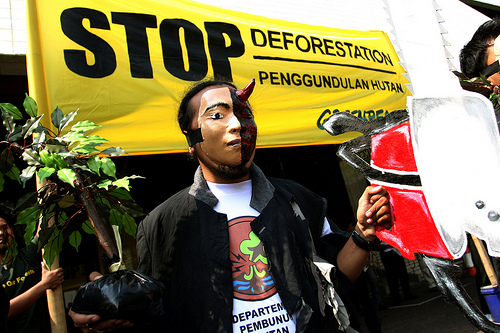
Indonesia has been highlighted as one of the predominant participants in the REDD program in the international arena. Among 14 other countries that have received funding from the World Bank to pursue this climate mitigating market based program, Indonesia, since the COP 13 Bali Conference in 2007, has been attempting to create an extensive forestry program that would become a part of Indonesian President Susilo Bambang Yudhoyono's promise to reduce the country's carbon emissions by at least 26 percent by 2020 (REDD Indonesia, 2010).
Statistics
- Indonesia has a rich forest biosphere covering 60% of the country (Masripatin, 2009)
- It is the third largest tropical forest in the world (Cotula and Mayers, 2009)
†’ This rich resource pool has created a resource curse for the country making them largely dependent on its forested resource and causing severe pressure on its environment.
Exasperating Environmental Factors
- Illegal logging
- Unsustainable palm oil plantations
- Mismanaged agriculture practices
†’ Poor environmental management in Indonesia has led to the release of 20 per cent of the total global carbon emissions (Masripatin, 2009).
In order to curb Indonesia's environmental ills, in 2009, the government presented an R-Plan to the Forest Carbon Partnership Facility, under the World Bank, that called for more sustainable agriculture and forestry based initiatives on a provincial and local scale. The R-Plan's basis for implementation states that the Indonesian government sees "the potential of its forests to play a significant role in contributing positively towards climate change mitigation through delivering real reduction of emissions from deforestation and forest degradation and also through increased carbon sequestration, at the same time allow national development continue in a sustainable manner" (Masripatin, 2009).
Logistics of Indonesia's R-Plan (Click Here)
R – Plan Externalities: Indonesia's Indigenous Groups
Critical to our thesis however, is the role of local indigenous groups and the implication these nationally overseen programs have on their rights and livelihoods.
- There are 312 recognized indigenous groups in Indonesia
The hope behind REDD in Indonesia is that a financial influx from carbon credits from outside investors will help perpetuate economic growth in the country while also promoting sustainable forestry and agricultural practices.
- Two programs are currently underway in the country that "calls for hard investments in electrification projects, agro-forestry and timber plantations" (Dunlop, 2009).
While the plan appears socially and economically benevolent on paper there are major issues concerning the protection of indigenous groups.
- Land rights in Indonesia are under state control, but the country's current land tenure system is convoluted and gives indigenous populations little clout.
- Indigenous groups allocate their land based off customary land rights and the current law does not fully protect them (Cotula and Mayers, 2009).
- According to current legislation customary land rights can be removed for the sake of public (government) interest; i.e. REDD programs under the Ministry of Forestry's discretion.
- If indigenous groups are living on a proposed site for a REDD program they are considered to be illegally squatting on the land and are thus vulnerable to being pushed off their land for REDD's proposed "sustainable" palm oil plantations and logging (Cotula and Mayers, 2009).
[kml_flashembed movie="http://www.youtube.com/v/jnYLDECwvyE" width="425" height="350" wmode="transparent" /]Recommendations
- The Technical Advisory Panel under the Forest Carbon Partnership Facility and World Bank recommends the need for more multi-stakeholder cooperation in order to "balance top-down with bottom-up inputs" (Readiness Plan External Review, 2009).
- Without adequate cooperation with the local level, indigenous groups will lose access to their once rich wealth of resources from the forest (Ibid).